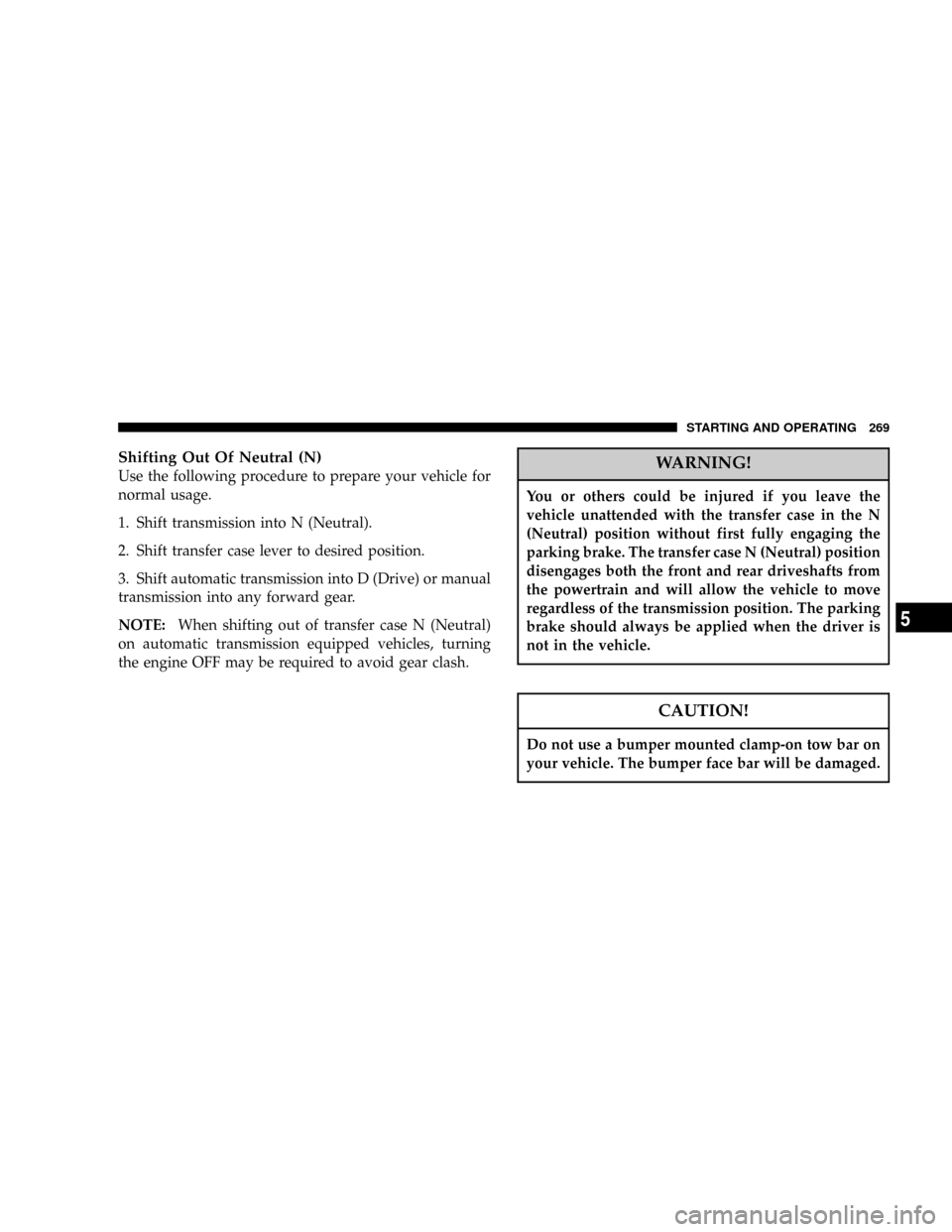Page 265 of 374
CAUTION!
If the trailer weighs more than 1,000 lbs (454 kg)
loaded, it should have its own brakes and they
should be of adequate capacity. Failure to do this
could lead to accelerated brake lining wear, higher
brake pedal effort, and longer stopping distances.
WARNING!
Connecting trailer brakes to your vehicle's hydraulic
brake lines can overload your brake system and
cause it to fail. You might not have brakes when you
need them and could have an accident.
²Whenever you pull a trailer, regardless of the trailer
size, stop lights and turn signals on the trailer are
mandatory for motoring safety.
²Follow the maintenance intervals in schedule ªBº for
changing the automatic transmission fluid and filter, if
you REGULARLY tow a trailer for more than 45
minutes of continuous operation.
STARTING AND OPERATING 265
5
Page 266 of 374
Minimum Vehicle Requirements for Trailer Towing
266 STARTING AND OPERATING
Page 267 of 374
RECREATIONAL TOWING (BEHIND
MOTORHOME, ETC.)
Towing ± 2WD Models
Recreational towing is not recommended. Provided that
the transmission is operable, tow only in N (Neutral) at
speeds not exceeding 45 mph (72 km/h) and distances
less than 100 miles (161 km).
If the vehicle is to be towed more than 100 miles (161 km),
the propeller shaft should be disconnected or place tow
dollies under the rear wheels.
Towing Ð 4WD Models
CAUTION!
Internal damage to the transfer case will occur if a
front or rear wheel lift is used when recreational
towing.
NOTE:The transfer case must be shifted into N (Neu-
tral) for recreational towing.
Shifting Into Neutral (N)
Use the following procedure to prepare your vehicle for
recreational towing.
STARTING AND OPERATING 267
5
Page 268 of 374

CAUTION!
It is necessary to follow these steps to be certain that
the transfer case is fully in N (Neutral) before
recreational towing to prevent damage to internal
parts.
1. Depress brake pedal.
2. Shift transmission into N (Neutral).
3. Shift transfer case lever into N (Neutral).
4. Start engine.
5. Shift automatic transmission into D (Drive) or manual
transmission into any forward gear.
6. Release brake pedal and ensure that there is no vehicle
movement.7. Shut the engine OFF and place the ignition key into
the unlocked OFF position.
8. Shift automatic transmission into P (Park) or ensure
manual transmission is in any forward gear.
9. Apply parking brake.
10. Attach vehicle to the tow vehicle with tow bar.
11. Release parking brake.
CAUTION!
Transmission damage may occur if the automatic
transmission is shifted into P (Park) with the transfer
case in N (Neutral) and the engine running. With the
transfer case in N (Neutral) ensure that the engine is
OFF prior to shifting the transmission into P (Park)
(refer to steps7±8above).
268 STARTING AND OPERATING
Page 269 of 374

Shifting Out Of Neutral (N)
Use the following procedure to prepare your vehicle for
normal usage.
1. Shift transmission into N (Neutral).
2. Shift transfer case lever to desired position.
3. Shift automatic transmission into D (Drive) or manual
transmission into any forward gear.
NOTE:When shifting out of transfer case N (Neutral)
on automatic transmission equipped vehicles, turning
the engine OFF may be required to avoid gear clash.WARNING!
You or others could be injured if you leave the
vehicle unattended with the transfer case in the N
(Neutral) position without first fully engaging the
parking brake. The transfer case N (Neutral) position
disengages both the front and rear driveshafts from
the powertrain and will allow the vehicle to move
regardless of the transmission position. The parking
brake should always be applied when the driver is
not in the vehicle.
CAUTION!
Do not use a bumper mounted clamp-on tow bar on
your vehicle. The bumper face bar will be damaged.
STARTING AND OPERATING 269
5
Page 271 of 374
WHAT TO DO IN EMERGENCIES
CONTENTS
mHazard Warning Flashers.................272
mIf Your Engine Overheats.................273
mChanging A Flat Tire....................274
NJack And Lug Wrench Locations...........274
NSpare Tire Location....................275NTire Changing Procedures...............275
mJump Starting Procedure..................279
mEmergency Tow Hooks Ð If Equipped........281
mTowing A Disabled Vehicle................281
6
Page 274 of 374
CHANGING A FLAT TIRE
Jack And Lug Wrench Locations
The jack, jack handle, and lug wrench are stored beneath
the right rear seat. To remove the jack from its stowage
position, turn the thumb screw counterclockwise to
loosen jack assembly and then remove it.
WARNING!
²Always store the jack, lug wrench and spare, flat
or damaged tire securely in the proper place.
Never leave them loose in the vehicle where they
could become dangerous projectiles during a
quick stop or collision.
²The jack is designed to use as a tool for changing
tires only. The jack should not be used to lift the
vehicle for service purposes, unless suitable sup-
ports are placed under the vehicle as a safety
measure. The vehicle should be jacked on a firm
level surface only. Avoid ice or slippery areas.
274 WHAT TO DO IN EMERGENCIES
Page 277 of 374
5. Raise the vehicle by turning the jack handle clockwise
until the tire clears the ground.
WARNING!
Raising the vehicle higher than necessary can make
the vehicle less stable and cause an accident. It could
slip off the jack and hurt someone near it. Raise the
vehicle only enough to remove the tire.
6. Remove the lug nuts and wheel.
7. Position the spare wheel/tire on the vehicle and install
lug nuts with cone-shaped end toward wheel. Lightly
tighten nuts clockwise. To avoid the risk of forcing the
vehicle off the jack, do not tighten the nuts fully until the
vehicle has been lowered.
8. Lower the vehicle by using a counterclockwise rota-
tion to lower the jack.
Rear Scissor Jack Location
WHAT TO DO IN EMERGENCIES 277
6